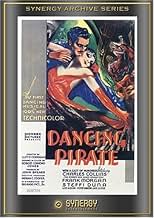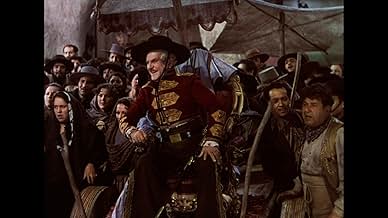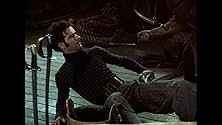Füge eine Handlung in deiner Sprache hinzuThe story of a Boston dance teacher who gets shanghaied by buccaneers who might make his next steps be off the plank!The story of a Boston dance teacher who gets shanghaied by buccaneers who might make his next steps be off the plank!The story of a Boston dance teacher who gets shanghaied by buccaneers who might make his next steps be off the plank!
- Für 1 Oscar nominiert
- 3 Gewinne & 1 Nominierung insgesamt
The Royal Cansino Dancers
- Royal Cansinos
- (as Cansino Family)
Sam Appel
- Café Owner
- (Nicht genannt)
Eduardo Cansino
- Specialty Dancer
- (Nicht genannt)
Nora Cecil
- Landlady
- (Nicht genannt)
Jim Farley
- Sailor
- (Nicht genannt)
Rita Hayworth
- Specialty Dancer
- (Nicht genannt)
Cy Kendall
- Bouncing Betty's Cook
- (Nicht genannt)
Empfohlene Bewertungen
In 1820, handsome dance instructor Charles Collins (as Jonathan Pride) decides to visit his aunt in California. Young Mr. Collins thrills the ladies by waltzing with his hands touching their waists. Leaving his giddy pupils wanting more, Collins takes the long route - around the continent of South America. Armed with only his satchel and an umbrella (to return to his aunt), Collins is mistaken for a pirate. As the "Dancing Pirate", he holds up in the western town of La Paloma. There, he dances, faces danger, and falls in love with lovely Senorita Steffi Duna (as Serafina Perena), daughter of the town's bumbling mayor, Frank Morgan (as Don Emilio Perena).
The well-staged "Finale" earned an "Academy Award" nomination for dance director Russell Lewis. Leading man Collins looks like he had everything needed to become a major star - possibly, he found himself in the wrong studio, at the wrong time. Without the takes afforded the standard era star (Fred Astaire), he manages to be dazzling, in his solo routines. The scene with Collins' umbrella stuffed down the front of his pants provides a visual worthy of a Mae West double-entendre. Mr. Morgan isn't a very convincing "Don", but he is always a film asset. Ms. Duna, a Hungarian woman, is a beautiful and believable Senorita.
Currently, this film is more available in "black & white" than "color" - this is not always a disadvantage, but "Dancing Pirate" really should be seen in color. Although my "Hollywood Legends" VHS Madacy HWGL-5512 says "B & W" on the sleeve, this release of film IS definitely "in color". It most certainly does NOT star cover-girl Rita Hayworth, however. Ms. Hayworth, Pat Nixon, and Marjorie Reynolds can be spotted among the dancing extras (provided you know who you are looking for well enough to spot them).
****** Dancing Pirate (5/22/36) Lloyd Corrigan ~ Charles Collins, Steffi Duna, Frank Morgan
The well-staged "Finale" earned an "Academy Award" nomination for dance director Russell Lewis. Leading man Collins looks like he had everything needed to become a major star - possibly, he found himself in the wrong studio, at the wrong time. Without the takes afforded the standard era star (Fred Astaire), he manages to be dazzling, in his solo routines. The scene with Collins' umbrella stuffed down the front of his pants provides a visual worthy of a Mae West double-entendre. Mr. Morgan isn't a very convincing "Don", but he is always a film asset. Ms. Duna, a Hungarian woman, is a beautiful and believable Senorita.
Currently, this film is more available in "black & white" than "color" - this is not always a disadvantage, but "Dancing Pirate" really should be seen in color. Although my "Hollywood Legends" VHS Madacy HWGL-5512 says "B & W" on the sleeve, this release of film IS definitely "in color". It most certainly does NOT star cover-girl Rita Hayworth, however. Ms. Hayworth, Pat Nixon, and Marjorie Reynolds can be spotted among the dancing extras (provided you know who you are looking for well enough to spot them).
****** Dancing Pirate (5/22/36) Lloyd Corrigan ~ Charles Collins, Steffi Duna, Frank Morgan
I saw this movie when I was five years old and never heard of it again. All I could remember was the fellow dancing with a noose around his neck. Looked for it for years, then saw it, just in the past year, in a bin as a Rita Hayworth movie. Thanks to the generic title I recognized it right away. There won't be many comments on this one, as it's virtually unknown, but I've looked at it twice and it brings back a memory of a movie I loved so much as a child, though nothing came back to me except the mentioned dancing scene. It's offbeat, in terrific color and I think enjoyable . Did anybody ever hear of the dancer who played the title role again?
The impressive vivid colors produced by the three-strip system of Technicolor's first two feature films were beginning to perk the interest of Hollywood to the new technology. The third full-length motion picture to be released using the company's new film stock was May 1936's "Dancing Pirate," cinema's first feature film musical shot in that format.
"It's incredible how far a picture can get on great color, good dancing, and solid jokes," described film reviewer Andrew Wickliffe on "Dancing Pirate." Critic James Harrison added at the time of its release, "'Dancing Pirate' is an amusing diversion and a treat for the eyes when the dazzling Technicolor lights up the screen. The dancing of all involved is as good and pleasurable as any major studio production." For years after its release, "Dancing Pirate" fell into obscurity, with only a cheap 16mm two-color Cinecolor process available. Then collector Wade Williams stepped forward with his private 35mm pristine copy. A restoration with 4K scan was performed, and the film, with Rita Hayworth, Pat Ryan (President Nixon's future wife), and Marjorie Reynolds appearing as three of the many dancers, was shown in a pristine print.
Pioneer Pictures, a subsidiary of RKO Pictures and producers of the first three-strip Technicolor feature film, 1935 "Becky Sharp," was responsible for "Dancing Pirate." Adapted from Emma-Lindsay Squier's 1930 Colliers Magazine story 'Glorious Buccaneer,' the movie centers around Jonathan Pride (Charles Collins), a Boston dance instructor in 1920 who is captured by pirates and sails to California as a slave. He escapes to a small coastal town where he is to be hanged for piracy. Serafina (Steffi Duna), daughter to the mayor (Frank Morgan), intercedes shortly before his execution with the stipulation Jonathan teaches her and her friends how to waltz.
Collins was a Broadway performer who had done film work since 1932, but "Dancing Pirate" was his biggest role yet. Married to dancer/actress Dorothy Stone, Collins had appeared in several films, live plays and a nightclub act with his wife. He never reached the top tier of actors mainly because most felt he was too tall and lean. Collins last appeared in the 1984 TV show 'The Master,' where his character reminisces about his audition for "Dancing Pirate." He died in 1999 at age 95.
"It's incredible how far a picture can get on great color, good dancing, and solid jokes," described film reviewer Andrew Wickliffe on "Dancing Pirate." Critic James Harrison added at the time of its release, "'Dancing Pirate' is an amusing diversion and a treat for the eyes when the dazzling Technicolor lights up the screen. The dancing of all involved is as good and pleasurable as any major studio production." For years after its release, "Dancing Pirate" fell into obscurity, with only a cheap 16mm two-color Cinecolor process available. Then collector Wade Williams stepped forward with his private 35mm pristine copy. A restoration with 4K scan was performed, and the film, with Rita Hayworth, Pat Ryan (President Nixon's future wife), and Marjorie Reynolds appearing as three of the many dancers, was shown in a pristine print.
Pioneer Pictures, a subsidiary of RKO Pictures and producers of the first three-strip Technicolor feature film, 1935 "Becky Sharp," was responsible for "Dancing Pirate." Adapted from Emma-Lindsay Squier's 1930 Colliers Magazine story 'Glorious Buccaneer,' the movie centers around Jonathan Pride (Charles Collins), a Boston dance instructor in 1920 who is captured by pirates and sails to California as a slave. He escapes to a small coastal town where he is to be hanged for piracy. Serafina (Steffi Duna), daughter to the mayor (Frank Morgan), intercedes shortly before his execution with the stipulation Jonathan teaches her and her friends how to waltz.
Collins was a Broadway performer who had done film work since 1932, but "Dancing Pirate" was his biggest role yet. Married to dancer/actress Dorothy Stone, Collins had appeared in several films, live plays and a nightclub act with his wife. He never reached the top tier of actors mainly because most felt he was too tall and lean. Collins last appeared in the 1984 TV show 'The Master,' where his character reminisces about his audition for "Dancing Pirate." He died in 1999 at age 95.
Boston dance teacher Charles Collins is shangaied by pirates. He escapes from them in Spanish California, where he is about to be hanged by Alcalde Frank Morgan (!). Morgan's daughter, Steffi Duna saves him on condition he will teach her the waltz. While this is going on, renegade captain Victor Varconi marches in with his troops. He plans to marry Miss Duna, receiving a dowry of hundreds of thousands of acres and tens of thousands of cattle.
Although I looked at a black&white copy, this was the third feature shot in 3-strip Technicolor, and the costuming betokens this. The story is silly and conventional for the era, and there are plenty of skilled farceurs in the cast, including Luis Alberni, with one immense production number feature Eduardo Cansino -- Rita Hayworth's father -- and his dance troupe. As an actor, Collins is a good dancer. He was born in 1904, and married dance partner Dorothy Stone, with whom he appeared in several Broadway musicals through 1945. His movie career was limited. Another film lead was his in 1944, but he appeared in a total of a dozen shorts and features from 1932 through being part of the chorus in THE WIZ. He died in 1999.
Although I looked at a black&white copy, this was the third feature shot in 3-strip Technicolor, and the costuming betokens this. The story is silly and conventional for the era, and there are plenty of skilled farceurs in the cast, including Luis Alberni, with one immense production number feature Eduardo Cansino -- Rita Hayworth's father -- and his dance troupe. As an actor, Collins is a good dancer. He was born in 1904, and married dance partner Dorothy Stone, with whom he appeared in several Broadway musicals through 1945. His movie career was limited. Another film lead was his in 1944, but he appeared in a total of a dozen shorts and features from 1932 through being part of the chorus in THE WIZ. He died in 1999.
The Dancing Pirate is worth watching for a several reasons: the over-the-top early Technicolor hues, the spectacular finale featuring the Royal Cansino Dancers (including a young Rita Hayworth) and a very small appearance at the beginning of the movie by Pat Ryan, later to be Pat Nixon. But more than these things, I like The Dancing Pirate as a forgotten movie about Los Angeles. The movie depicts a Boston dance teacher kidnapped by pirates who escapes into the sleepy Alta California village of La Paloma.
This is an obvious adaptation of the real-life story of Joseph Chapman. Chapman, originally from Boston, deserted Hippolyte de Bouchard's piratical coastal raiding party to become the first yanqui resident of Los Angeles in 1818. Chapman, like the character in the movie, became a solid citizen of the little pueblo. Unlike the character in the movie, there's no historical evidence that Chapman could dance, however.
This is an obvious adaptation of the real-life story of Joseph Chapman. Chapman, originally from Boston, deserted Hippolyte de Bouchard's piratical coastal raiding party to become the first yanqui resident of Los Angeles in 1818. Chapman, like the character in the movie, became a solid citizen of the little pueblo. Unlike the character in the movie, there's no historical evidence that Chapman could dance, however.
Wusstest du schon
- WissenswertesWhile this was the third feature film released in 3-strip Technicolor, it was, for a long time, thought to no longer exist in that form. Only incomplete 35mm negatives were known to survive, plus 16mm prints struck in the two-color Cinecolor process. However, in 2015, a complete 35mm nitrate Technicolor print was discovered, leading to a 2022 home video release on DVD and Blu-ray.
- Crazy CreditsThe following is included in the opening crew credits, in an era when color was still relatively unused in filming and Technicolor was becoming in vogue: "Designed in Color by Robert Edmond Jones"
- Alternative VersionenSome prints of this film are not even in color, but in black-and-white, although the credits still say "Technicolor".
- SoundtracksWhen You're Dancing the Waltz
Music by Richard Rodgers
Lyrics by Lorenz Hart
Performed by Charles Collins (uncredited), Steffi Duna (uncredited) and chorus
Top-Auswahl
Melde dich zum Bewerten an und greife auf die Watchlist für personalisierte Empfehlungen zu.
Details
- Erscheinungsdatum
- Herkunftsland
- Sprachen
- Auch bekannt als
- Gusarske noći
- Drehorte
- Produktionsfirma
- Weitere beteiligte Unternehmen bei IMDbPro anzeigen
- Laufzeit
- 1 Std. 23 Min.(83 min)
- Seitenverhältnis
- 1.37 : 1
Zu dieser Seite beitragen
Bearbeitung vorschlagen oder fehlenden Inhalt hinzufügen

































